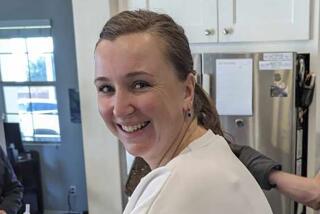How rescuers found the NCC professor who trekked 26 miles in the snow through the Grand Canyon
- Share via
Reporting from Las Vegas — The snow was at least 3 feet deep and still falling when Tracy Glover and two other men came upon the fee booth at the North Rim entrance of the Grand Canyon.
The door to the booth was always unlocked, according to Glover, the Kane County, Utah, sheriff. Inside were sleeping bags, food, water, matches — items that Karen Klein could have used on this particular Christmas Eve as she and her family found themselves stranded in a remote region of the National Park near the Arizona-Utah border. It was an oasis of warmth within a freezing forest.
“I thought she might’ve made it there,” Glover said.
NEWS
But after walking 26 miles, dragging a bad left leg with no shoe through the snow, Klein had found another shelter instead — a cabin nestled in the trees about 100 yards away with no power and just a few blankets. She had to break a window to gain entry.
“It might’ve been colder in there than it was outside,” Glover said.
About 5 hours after entering the park, Glover reached the cabin. When he found Klein, she had stripped off her wet beanie and outer layers of clothing and was lying on the bed. She was exhausted. Dehydrated. She had been hallucinating. Frostbite had gotten to her toes and fingers. Glover said they quickly built a fire in the cabin and called a dispatcher to relay the message to her husband and son, who had been rescued hours earlier: Karen Klein was alive.
“It’s in my top 10 of highlights,” Glover said Tuesday. “Definitely one of the better [search and rescue cases], since it ended well and ... all the agencies came together so quickly on it.”
Klein, 46, a Northampton Community College professor from Palmer Township, was on vacation in Las Vegas with her husband and 10-year-old son when they decided to hit Bryce Canyon and the North Rim of the Grand Canyon on Christmas week. But on the drive to the North Rim, their GPS alerted them to the closure of Arizona Highway 67.
It diverted them onto a Forest Service road that is mostly gravel. The car eventually got stuck. Worry settled in.
With no cellphone service and Eric Klein recently recovering from a back injury, Karen Klein, a triathlete, decided to hike for help as snow kept falling. She ended up traversing 26 miles over the course of about 36 hours before Glover found her in the small cabin.
She told “Good Morning America” that as she hiked in search of help, she forced herself to stay awake at night and ate twigs from an aspen tree. She put snow in her cheek to try to stay hydrated.
“I kept thinking, this isn’t how my life is supposed to end, no, no, no,” Klein said. “My son needs his mother, my husband needs his wife. I am not letting my mother bury me.”
Coconino County, Ariz., Sheriff Jim Driscoll had been waiting at the hospital with Eric Klein and the boy for word that she’d been found. Driscoll, who has been doing search and rescue operations for 40 years, said he did what he normally does in these circumstances — interviews the family to try to profile the person they’re searching for.
He said he found out she was athletic and in good shape. She had some practical outdoor skills. She was a fighter. It told him she was likely on the move.
“I was looking for clues,” he said. “Because of the temperatures and the storm that was coming, we had to throw everything we had at it.”
I kept thinking, this isn’t how my life is supposed to end, no, no, no.
— Karen Klein
That storm was going to dump at least 18 inches, which would’ve slowed down the rescue attempt dramatically, Driscoll said. He figured they had about an eight-hour window to find her.
Glover’s team was closer, however, and was able to begin searching on snowmobiles around 9 p.m. Driscoll’s team launched from Flagstaff, Ariz., and began around 11 p.m. All told, about a dozen rescuers were involved, with help from the National Park Service, U.S. Forest Service and Bureau of Land Management.
Glover said tracking Klein was difficult. She had stayed on the road at times, but the tracks would disappear and then be picked up off the road. Snowdrifts were building, and the slight blemishes in the snow where her tracks had been became harder to see.
By the time they got to the intersection of Highway 67 and Forest Road 22, Glover said, they’d lost her tracks again. At about 8,500 feet, dehydration, falling body temperature and exhaustion were big concerns.
“We had tracked her for 26 miles, and it seemed around every corner we were surprised she was still going. It was pretty rough conditions and the snow was getting deeper,” he said. “When we got to the intersection and then the fee booth, it was eerie. No tracks, no nothing.”
Glover said he didn’t know there was a cabin so close to the fee booth, but he found what looked like might’ve been her tracks, which led them to where she was.
“She was very disoriented and it took her a few minutes to acknowledge we were even in there,” Glover said. “She was so physically exhausted, she really couldn’t do anything. We gave her some food and water and then she started to come around.”
We had tracked her for 26 miles, and it seemed around every corner we were surprised she was still going.
— Tracy Glover
Driscoll said he was with Eric and his son when the dispatcher called to let him know she was alive. She was driven in a snowcat to a waiting ambulance and taken to the hospital, where she is being treated for her injuries.
Driscoll said he spoke to her in-laws Tuesday, and they told him there was a good chance she wouldn’t lose her toes to the frostbite.
He said she’s fortunate; in the last month, three people have died due to exposure to the cold in Cococino County.
“It can be a pretty hostile environment,” he said. “Especially at night.”
Twitter: @davemontero
More to Read
Sign up for Essential California
The most important California stories and recommendations in your inbox every morning.
You may occasionally receive promotional content from the Los Angeles Times.










